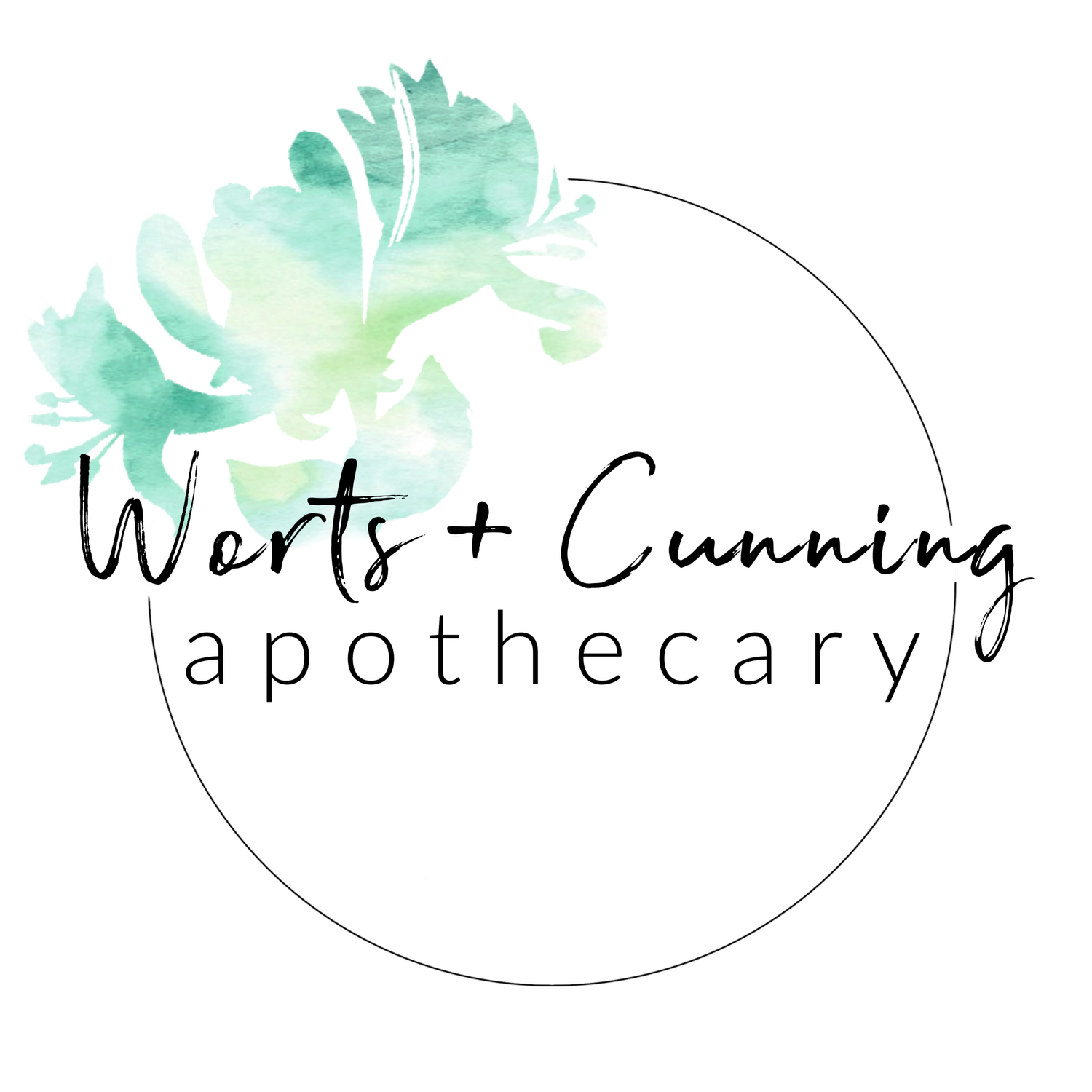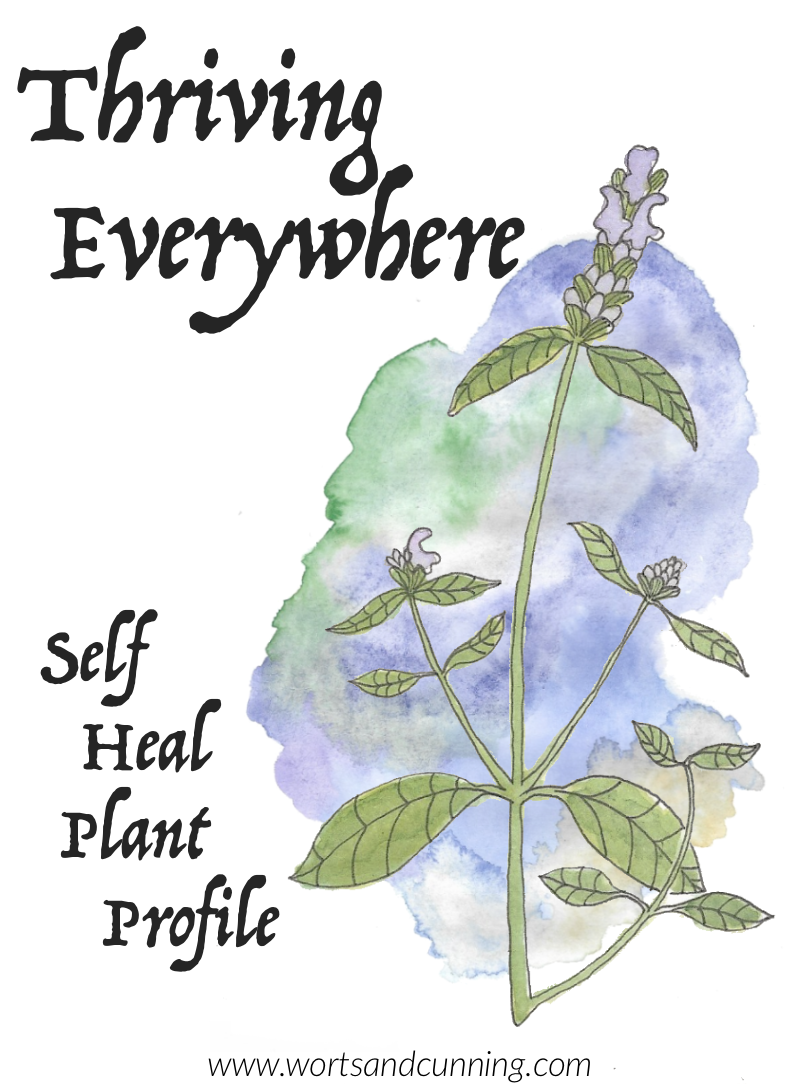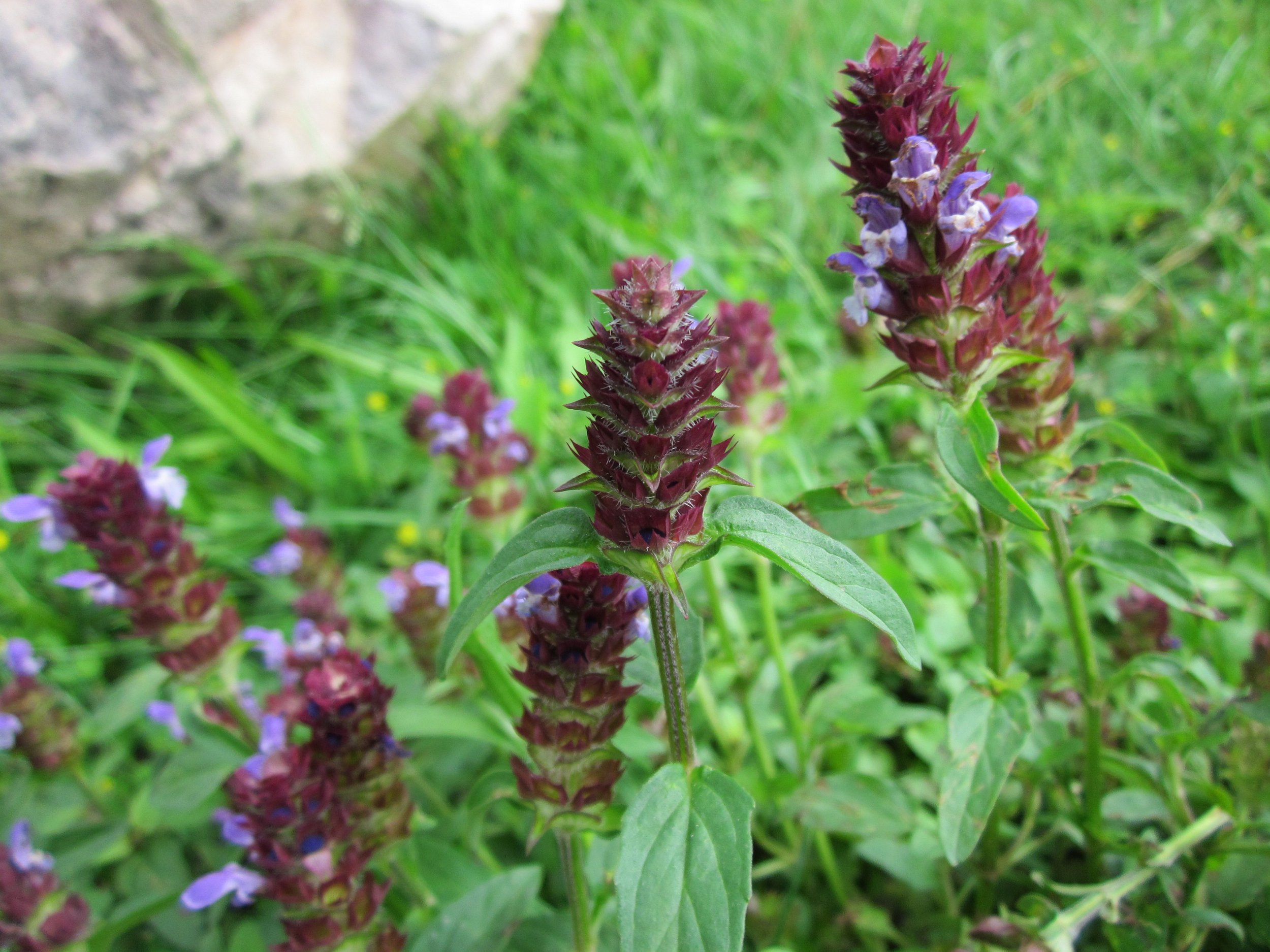Thriving Everywhere: Self Heal Plant Profile
When I moved to Nisenan and Miwkoʔ Waaliʔ land / Sacramento, one of the first plants I noticed that was new to my eyes was this little purple flower that seemed to show up in everyone’s front lawn.¹ A careful look through plant identification books revealed to me that this was Self Heal (Prunella vulgaris), a plant I’d learned about in my studies as an herbal student, but not one that I’d ever seen in person before. It’s always exciting to meet a plant friend you’ve only read about and since then I’ve worked a lot with beloved Self Heal.
In the part of California that I’m in, Self Heal grows everywhere much like California Poppy (Eschscholzia californica) or Dandelion (Taraxacum officinale). It’s a common wayside herb and it’s healing gifts are tied up with the health of working people out in the fields, carpenters and farmers, laborers and Travelling folk. I find their energy to be steadying, their ability to inspire hope in the healing process enduring. Self Heal is a wonderful herb to work with and I hope that you’ll find the following plant profile of use to your own studies and practice.
Enjoy!
Self Heal
(Prunella vulgaris)
Common + Folk Names : Heal-all, common selfheal, all-heal, blue curls, carpenter's herb, dragonhead, heart of the earth, Hercule's woundwort, hook heal, pimpernel, sickle wort, woundwort, consuelda, ingijbinaa
Tarot Cards : The Chariot, The Tower, The Devil, The Tens (Minor Arcana)
Element : Water, Earth
Zodiac Signs : Virgo (Guardian & Remedy), Gemini (Remedy), Aries (Remedy)
Planets : Venus
Moon Phase : New Moon
Parts used : Aerial parts
Habitat : Naturalized throughout Europe, Asia, North America, and North Africa. Often found in shady edges of woods, fields, roads, and yards.
Growing conditions : Low growing perennial that prefers moist soil and part to full sun.
Collection : Spring and early summer when it has started to flower.
Flavor : Bittern pungent, sweet
Temperature : Cold
Moisture : Dry
Tissue State : Heat, Tension, Stagnation (learn more about traditional western herbalism energetics)
Constituents : Beta-carotene, vitamin B1, vitamin C, vitamin K, zinc, flavonoids, pentacyclic triterpenes, rosmarinic acid, essential oils, tannin.
Actions : Alterative, antibacterial, antibiotic, antimutagenic, antioxidant, antiseptic, antispasmodic, antiviral, astringent, bitter, carminative, cholagogue, diuretic, febrifuge, hemostatic, hypotensive, immunostimulant, kidney tonic, liver stimulant, stomachic, styptic, vasodilator, vermifuge, vulnerary.
Main Uses : Self Heal is one of my "how about a little" herbs, in that I'll come to the end of making a blend and I'll think "how about a little Self Heal" and add a pinch of it to the herbs already assembled. As Culpeper writes, "Here is another herb of Venus, Self-heal, whereby when you are hurt you may heal yourself: It is a special herb for inward and outward wounds.”²
One of the reasons that Self Heal is so useful and easy to add to many an herbal blend is that it addresses inflammation in the body in multiple ways. Reducing inflammation can be a key component to alleviating many diseases and imbalances making Self Heal so versatile. Self Heal clears heat from the body by improving the efficiency of the liver and kidneys, as well as by acting as a blood tonic. As a lymphatic tonic, Self Heal addresses stagnation and the issues that can arise from it such as congested and swollen glands, which can lead to infections. Finally, Self Heal addresses inflammation as an immunomodulator, appropriately enhancing the body's immune response and helping to moderate an over-responsive immune response.
Many of the key indications for Self Heal are related to excess heat and especially excess stagnant heat which results in swelling and engorgement. Conditions like mastitis can often be helped using Self Heal both internally and externally (alongside other mastitis herbs like Phytolacca americana), as well as alleviating the pain of fibrocystic breast tissue, sore nipples, and general swelling. Other indications for Self Heal include pain caused by tension including tension headaches, neck, shoulder, and back pain, as well as dizziness and vertigo caused by hypertension. The herb can be useful in autoimmune conditions "as manifested by joint pains, low-grade fever, fatigue."³ As an anti-inflammatory, cooling tonic, Self Heal is also a good herb to turn to in case of fever (combine with Eupatorium perfoliatum to help with painful fevers). The herb is useful in damp lung conditions including wet coughs and congestion as well as more serious conditions like tuberculosis. Within Traditional Chinese Medicine, Self Heal continues to be used in treating tumors both malignant and benign and there has been research showing that Self Heal might be useful in the treatments of some cancers. In general, it is a good ally for processes of detoxification.
Self Heal has long been used as an herb for all complaints of the mouth and throat including sore throats, tonsillitis, laryngitis, mouth ulcers, bleeding gums, and gum disease in general. Use as a gargle and as a tea, but it can also be applied externally as a compress to the neck. In fact, the Latin binomial for Self Heal, Prunella, "was originally Brunella or Brunellen, a name given to it by the Germans as it was used to treat die Breuen, an inflammatory mouth and throat problem, common to soldiers in garrisons."⁴ As I mentioned earlier, many herbalists like myself reach for Self Heal to help harmonize and enhance an herbal blend, but also help to tend to the emotional wounds that can appear alongside physical ones. Herbalist Deb Soule writes:
“For years I had felt that a plant with the name self-heal must have the gift of healing internal wounds that cause feelings of sadness, grief, despair, anger and hopelessness. I began adding small amounts of the tincture of self-heal along with other herbs to enhance the healing properties of a formula. Sometimes I add a few dried flowers of self-heal to a tea mixture to help facilitate a deeper, more inward healing process.”⁵
Self Heal was one of the first flower essences I worked with and it was introduced to me as the type of essence that most anyone would benefit from working with. Self Heal helps us to connect with the belief that healing is even a possibility. I like making an herbal massage oil with both the herb and essence of Self Heal, using it for general body care, reducing lymphatic swelling, and supporting the emotional body through the physical one.
Topically, Self Heal continues to act as a useful anti-inflammatory that draws out heat from wounds and injuries alongside its antiseptic qualities. Many of Self Heal's common names like "carpenter's herb" and "sickle wort" refer to its use by laborers working with sharp tools who were able to harvest this freely growing herb easily. Use the herb as a wash for wound care, liniment, and/or salve for bruises, sprains, strains, boils, and burns. Also a good choice for bug bites and stings (great to use alongside Plantago spp. if you happen to get stung by a bee or other insect when out and about). Used internally and externally, Self Heal is a good ally for hemorrhoids, piles, and ulcers, as well as acne, rashes, and other skin irritations. Use as a compress for back pain, muscle and joint pain, as well as headaches. For those prone to tension headaches, consider combining with Blue Vervain (Verbena officinalis) and/or Skullcap (Scutellaria lateriflora). Self Heal is also useful as an eyewash for cases of conjunctivitis.
Finally, I want to share a description from Anishinaabe mashkikiiwikwewag, Keewaydinoquay, about Self Heal that so succinctly sums up the beauty of Self Heal's (ingijibinaa) healing gifts:
“If it has a nice place to grow in, a moist and sunny or semishaded place, this plant can grow to be eighteen inches tall, but if it is growing on a suburban lawn that is dry and regularly mowed, it can be two inches tall. In either extreme it will endeavor to put out its little flower and live a full life. As Kee used to say, ‘If a little weed can do that, so can people.’”⁶
Magickal Uses : A great herb to add to any healing bundles, spells, rituals, and charms. Helps to give courage to those seeking healing, especially those folks who have been worn down and feel hopeless about their ability to feel well again. Dr. JJ Pursell shares in her annotated guide to Culpeper's Complete Herbal that she was "taught to use self-heal topically whenever I was bitten in a dream because the energetic bite must be treated." I love this bit of herbal tradition of tending to wounds sustained in dreams in the waking world. While Self Heal was not recommended to me specifically, I received similar instructions on working with plants and dreams, and find that it's such a lovely way of helping the body settle after a particularly intense dream or nightmare. It is a very sweet form of somatic magick and calling the spirit home to the body.
The Self-Heal Personality : There are two key Self Heal personalities that I've most often come across. The first is the person who on the surface appears to have given up any responsibility for their own healing. They strongly cling to the belief that it is only something or someone outside of themselves that will make them well and that their ability to feel well is not something they have any control over. Sometimes this ties into patterns of addiction to substances, people, and experiences as a way to cope. Deeper beneath this is a belief that not only is feeling well not something they can access through their own effort (alongside appropriate therapeutic, community, and medicinal support), but that they do not deserve to be well. This wound is a deep one and often stems from early childhood experiences, but not exclusively. Self Heal can help them to realize that to feel well and supported in their wellness is a human right and to begin to question their own beliefs around their deservedness. Ultimately, Self Heal helps the to feel a sense of empowerment in being responsible for seeking, cultivating, and receiving what they need to feel well.
The second Self Heal personality I've come across is a person who has done a good amount of inner work, they have a rather secure belief in their ability to seek out and know feelings of wellness, and then something bubbles to the surface that they were not expecting. It may be a familiar pattern that they had thought they had already addressed but are now seeing from a different angle or an issue that they had not faced before because it needed to be uncovered by the healing work they've already done. Self Heal acts as an ally and guide in this process of understanding oneself and one's responsibilities even in areas of life where they believe they've already addressed it all. Instead of shame or humiliation or a feeling that they should've "healed better" before, Self Heal helps them feel humbled by the magick that is healing and responsibly empowered wherever this part of their healing journey is guiding them.
Contraindications : Generally considered safe.
Drug interactions : Avoid with insulin and hypoglycemic medications. Because of its liver stimulating qualities, it may reduce absorption of prescription drugs and supplements.
Dosage : Standard dosage. Anne McIntyre recommends an infusion of "two flowering spikes per cup of water 3 x daily."
᠅
If you would like an easy to access, downloadable, and printable version of this and all of my plant profiles, including Self Heal, you’re invited to join The Plant Ally Library.
As you explore the energies of Self Heal and other plant allies, you might be interested in other ways of supporting your healing practice from finding your rhythm with lunar rituals, creating your own oracle of care or cultivating a healing daily practice with tarot.
May you thrive wherever you find yourself, growing steady into the spaces that feel like home.
This post was made possible through patron support.
❤ Thank you, friends. ❤
Footnotes
1. There is a joke that if you take your herbalist friend for a walk where there are plants that it is less likely to be a walk with any momentum and more of a “Ooo! What’s that plant?” and “Oh! The {insert name of beloved plant} is looking lovely today!” stop-every-few-steps meandering. I say “joke” but it is more of a common reality for many an herbalist’s friend.
2. Nicholas Culpeper and J. J. Pursell, Culpeper's Complete Herbal: A Compendium of Herbs and Their Uses, Annotated for Modern Herbalists, Healers, and Witches (Portland, OR: Microcosm Publishing, 2022), 244.
3. Michael Alfs, 300 Herbs: Their Indications & Contraindications (New Brighton, MN: Old Theology Book House, 2003), 96.
4. Anne McIntyre, Flower Power: Flower Remedies for Healing Body and Soul through Herbalism, Homeopathy, Aromatherapy, and Flower Essences (New York: Henry Holt and Company, 1996), 186.
5. Deb Soule, 'Self Heal' Maine Organic Farmers and Gardeners, Spring 2005, https://www.mofga.org/resources/herbs/self-heal/ (accessed March 2023). Be sure to check out the beautiful recipes for massage oils and more that Deb provides in this profile.
6. Mary Siisip Geniusz, Plants Have So Much To Give Us, All We Have To Do Is Ask: Anishinaabe Botanical Teachings, (Minneapolis: University of Minnesota Press, 2015), 253.
7. Nicholas Culpeper and J. J. Pursell, 244.
8. Anne McIntyre, Dispensing with Tradition: A Practitioner's Guide to using Indian and Western Herbs the Ayurvedic Way (Cheltenham: Artemis House, 2012), 106.






